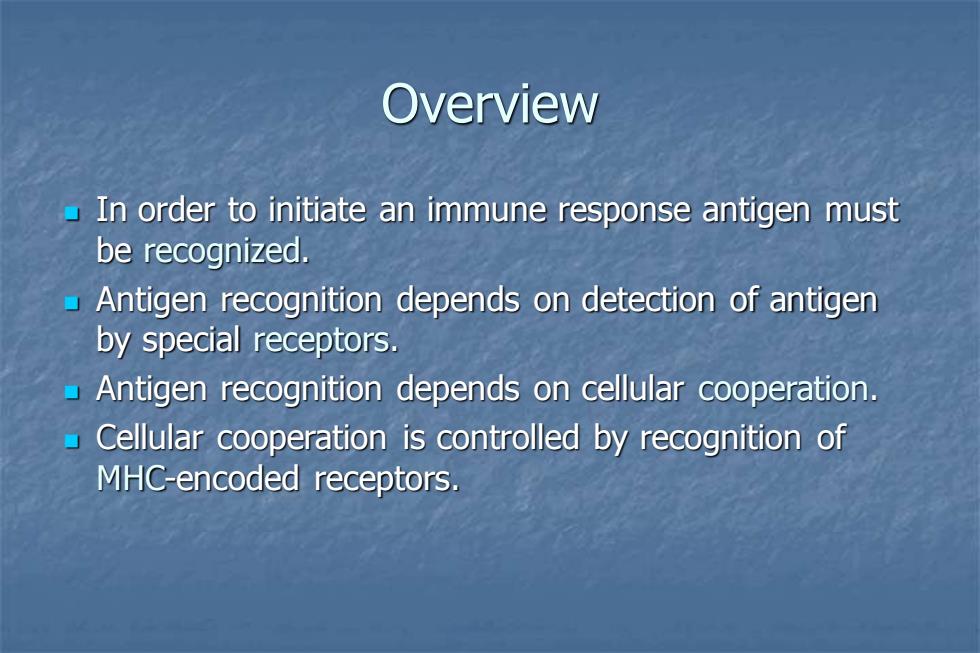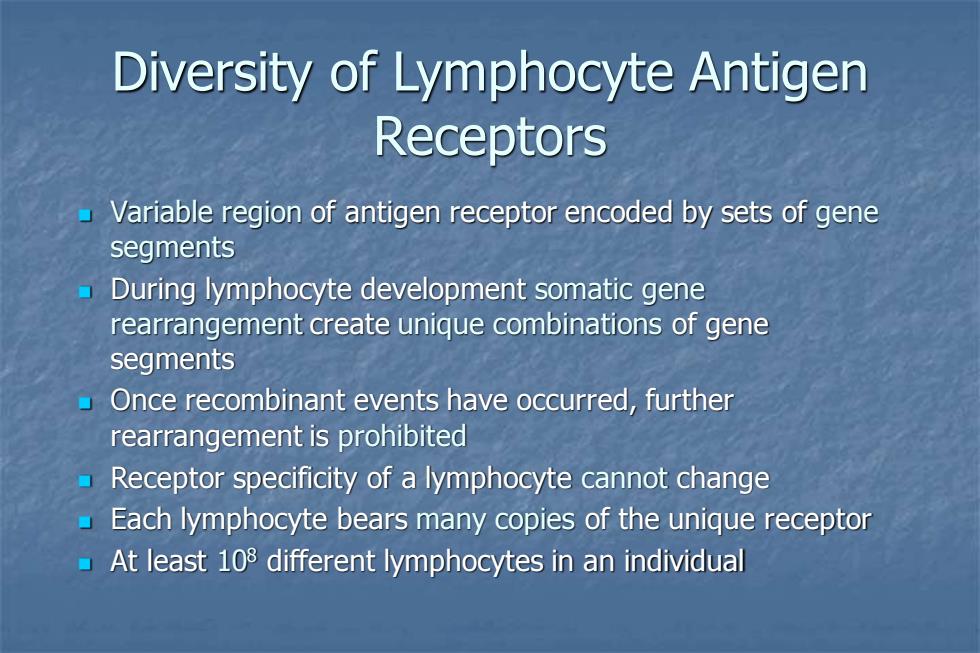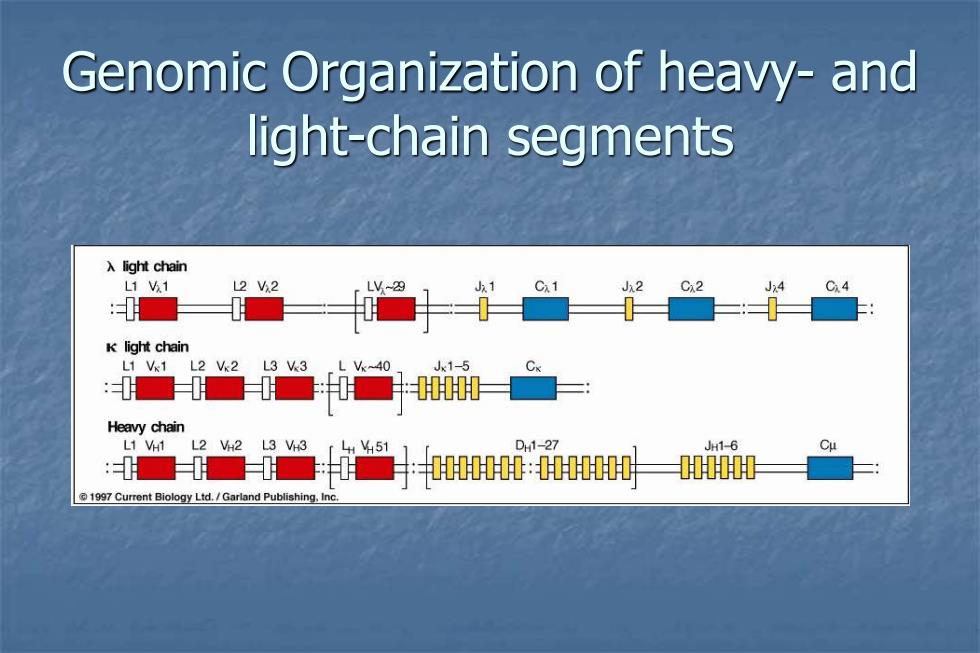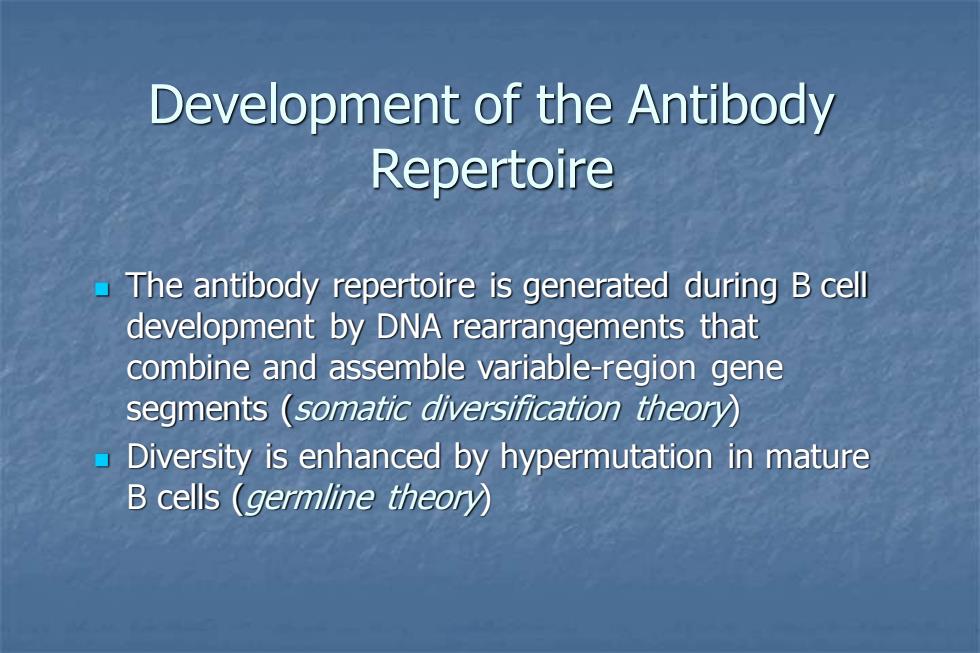
Lecture 15 Antigen Recognition
Lecture 15 Antigen Recognition

Overview In order to initiate an immune response antigen must be recognized. Antigen recognition depends on detection of antigen by special receptors. Antigen recognition depends on cellular cooperation. Cellular cooperation is controlled by recognition of MHC-encoded receptors
Overview ◼ In order to initiate an immune response antigen must be recognized. ◼ Antigen recognition depends on detection of antigen by special receptors. ◼ Antigen recognition depends on cellular cooperation. ◼ Cellular cooperation is controlled by recognition of MHC-encoded receptors

Clonal Selection Theory (F.Macfarlane Burnet) 0 pre-existence of of many different potential antibody producing cells each cell displays surface receptors for specific antigens antigen encounter selects cells What prevents recognition/destruction of self tissues?
Clonal Selection Theory (F. Macfarlane Burnet) ◼ pre-existence of of many different potential antibody producing cells ◼ each cell displays surface receptors for specific antigens ◼ antigen encounter selects cells ◼ What prevents recognition/destruction of self tissues?

Postulates of the Clonal Selection Hypothesis Each lymphocyte bears a single type of receptor of a unique specificity Interaction between a foreign molecule and a lymphocyte receptor capable of binding that molecule with high affinity leads to lymphocyte activation The differentiated efector cells derived from an activated lymphocyte will bear receptors of identical specificity to those of the parental cell from which that lymphocyte was derived Lymphocytes bearing receptors specific for self molecules are deleted at an early stage in lymphocyte development and are therefore absent from the repertoire
Postulates of the Clonal Selection Hypothesis ◼ Each lymphocyte bears a single type of receptor of a unique specificity ◼ Interaction between a foreign molecule and a lymphocyte receptor capable of binding that molecule with high affinity leads to lymphocyte activation ◼ The differentiated effector cells derived from an activated lymphocyte will bear receptors of identical specificity to those of the parental cell from which that lymphocyte was derived ◼ Lymphocytes bearing receptors specific for self molecules are deleted at an early stage in lymphocyte development and are therefore absent from the repertoire

Diversity of Lymphocyte Antigen Receptors Variable region of antigen receptor encoded by sets of gene segments During lymphocyte development somatic gene rearrangement create unique combinations of gene segments Once recombinant events have occurred,further rearrangement is prohibited Receptor specificity of a lymphocyte cannot change Each lymphocyte bears many copies of the unique receptor At least 108 different lymphocytes in an individual
Diversity of Lymphocyte Antigen Receptors ◼ Variable region of antigen receptor encoded by sets of gene segments ◼ During lymphocyte development somatic gene rearrangement create unique combinations of gene segments ◼ Once recombinant events have occurred, further rearrangement is prohibited ◼ Receptor specificity of a lymphocyte cannot change ◼ Each lymphocyte bears many copies of the unique receptor ◼ At least 108 different lymphocytes in an individual

Genomic Organization of heavy-and light-chain segments λlight chain L1 V1 22 K light chain L1 Vk1 L2 Vk2 L3 V3 L V-40 Jx1-5 ■H==; Heavy chain L11L2M2L33 H451 Dm1-27 JH1-6 H:t0一00 1997 Current Biology Ltd./Garland Publishing.Inc
Genomic Organization of heavy- and light-chain segments

Development of the Antibody Repertoire The antibody repertoire is generated during B cell development by DNA rearrangements that combine and assemble variable-region gene segments (somatic diversification theory) Diversity is enhanced by hypermutation in mature B cells (germline theory)
Development of the Antibody Repertoire ◼ The antibody repertoire is generated during B cell development by DNA rearrangements that combine and assemble variable-region gene segments (somatic diversification theory) ◼ Diversity is enhanced by hypermutation in mature B cells (germline theory)

Some Comments on Cluster of Differentiation/Designation(CD)Antigens _What are they? Differentiation antigens Expressed by cells at distinct stages of differentiation Expressed by cells having different functions How are they detected?
Some Comments on Cluster of Differentiation/Designation (CD) Antigens ◼ What are they? ◼ Differentiation antigens ◼ Expressed by cells at distinct stages of differentiation ◼ Expressed by cells having different functions ◼ How are they detected?

Fluorescence-Activated Cell Sorting (FACS) Mixture of cells is labeled with fluorescent antibody Q¥ 68 tbe (PMT) Streamof fud labeled oeis RedPMT CPU Side scatter Laser Forward scatter
Fluorescence-Activated Cell Sorting (FACS)

Lymphocyte Populations B lymphocytes Plasma cells T lymphocytes Helper/Inducer (CD4) ·Suppressor(CD8)
Lymphocyte Populations ◼ B lymphocytes ◼ Plasma cells ◼ T lymphocytes ◼ Helper/Inducer (CD4) ◼ Suppressor (CD8)